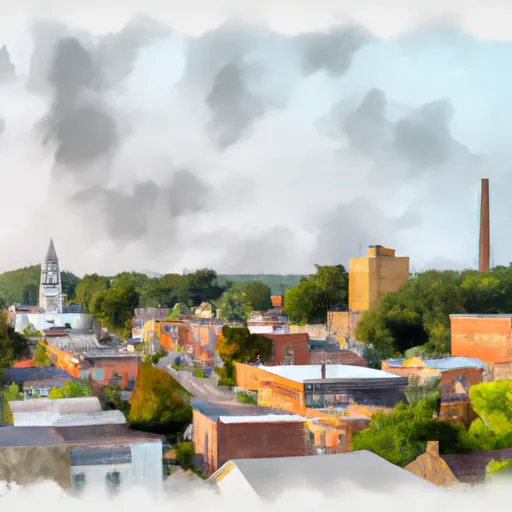-
 Snoflo Premium
Snoflo Premium
Get unlimited access to all our content
With no Ad interruptions! - Start Your Free Trial Login with existing account
Mount-Vernon
Eden Index
Climate
8.2
•
Recreation
2.2
•
Community
3.0
•
Safeguard
4.8/10

Located in Posey County, Indiana, Mount Vernon is a charming city with a population of approximately 7,000. The region experiences a humid continental climate, characterized by hot and humid summers and cold winters. Summers see temperatures averaging in the mid-80s°F, while winters can drop to the mid-30s°F.
Mount Vernon is surrounded by an extensive hydrology network, with the Ohio River flowing nearby. This river serves as a popular spot for various recreational activities, including boating, fishing, and swimming. The city is also home to several parks, such as Brittlebank Park, where visitors can enjoy picnicking, hiking, and bird-watching. Harmonie State Park, a short drive away, offers additional opportunities for camping, hiking, and wildlife observation.
For those seeking more adventurous outdoor experiences, the nearby Hoosier National Forest provides a diverse landscape with opportunities for hunting, fishing, horseback riding, and hiking. Additionally, the region's mild climate and scenic rural roads make it suitable for activities like cycling and motorcycle touring.
Overall, Mount Vernon, Indiana offers a pleasant climate, a variety of hydrology constituents, and numerous opportunities for outdoor recreation, making it an attractive destination for both residents and visitors alike.
What is the Eden Index?
The Snoflo Eden Index serves as a comprehensive rating system for regions, evaluating their desirability through a holistic assessment of climate health, outdoor recreation opportunities, and natural disaster risk, acknowledging the profound impact of these factors on livability and well-being.
Climate Health Indicator (CHI): 8.2
Mount-Vernon receives approximately
1170mm of rain per year,
with humidity levels near 83%
and air temperatures averaging around
14°C.
Mount-Vernon has a plant hardyness factor of
6, meaning
plants and agriculture in this region thrive during a short period during spring and early summer. Most
plants will die off during the colder winter months.
By considering the ideal temperature range, reliable water supplies, clean air, and stable seasonal rain or snowpacks, the Climate Health Indicator (CHI) underscores the significance of a healthy climate as the foundation for quality living.
A healthy climate is paramount for ensuring a high quality of life and livability in a region, fostering both physical well-being and environmental harmony. This can be characterized by ideal temperatures, reliable access to water supplies, clean air, and consistent seasonal rain or snowpacks.
Weather Forecast
Streamflow Conditions
Lower Ohio
Area Rivers
Lower Ohio
Snowpack Depths
Lower Ohio
Reservoir Storage Capacity
Lower Ohio
Groundwater Levels
Recreational Opportunity Index (ROI): 2.2
The Recreational Opportunity Index (ROI) recognizes the value of outdoor recreational options, such as parks, hiking trails, camping sites, and fishing spots, while acknowledging that climate plays a pivotal role in ensuring the comfort and consistency of these experiences.
Access to outdoor recreational opportunities, encompassing activities such as parks, hiking, camping, and fishing, is crucial for overall well-being, and the climate plays a pivotal role in enabling and enhancing these experiences, ensuring that individuals can engage in nature-based activities comfortably and consistently.
Camping Areas
| Campground | Campsites | Reservations | Toilets | Showers | Elevation |
|---|---|---|---|---|---|
| Forkland/McConnico Creek | 42 | 150 ft | |||
| Chickasaw State Park | 3 | 133 ft | |||
| Lock 5 | None | 99 ft | |||
| Lake Lurleen State Park | 91 | 276 ft | |||
| Lock 7 | None | 112 ft | |||
| Jennings Ferry | 52 | 109 ft | |||
| Runaway Branch | None | 87 ft | |||
| Foscue | 54 | 95 ft | |||
| Lock 8 | None | 123 ft | |||
| Belmont Park | None | 87 ft |
Nearby Ski Areas
Catastrophe Safeguard Index (CSI):
The Catastrophe Safeguard Index (CSI) recognizes that natural disaster risk, encompassing floods, fires, hurricanes, and tornadoes, can drastically affect safety and the overall appeal of an area.
The level of natural disaster risk in a region significantly affects safety and the overall livability, with climate change amplifying these risks by potentially increasing the frequency and intensity of events like floods, fires, hurricanes, and tornadoes, thereby posing substantial challenges to community resilience and well-being.
Community Resilience Indicator (CRI): 3.0
The Community Resilience Indicator (CRI) recognizes that education, healthcare, and socioeconomics are crucial to the well-being of a region. The CRI acknowledges the profound impact of these elements on residents' overall quality of life. By evaluating educational resources, healthcare accessibility, and economic inclusivity, the index captures the essential aspects that contribute to a thriving community, fostering resident satisfaction, equity, and social cohesion.

